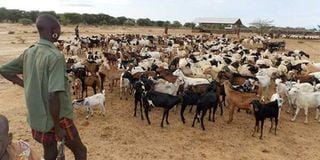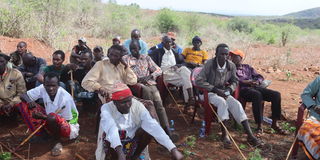Premium
Call for use of technology to combat cattle rustling

Turkana herders with animals recovered after a raid. The government has been urged to adopt modern technology in combating livestock theft.
Cattle rustling is a major headache for the government and Northern Kenya residents, with surveys showing an estimated Sh2.02 billion is lost yearly due to the outdated practice.
Livestock losses via theft and accidental deaths of herders, community members or security officers affect the success of livestock production.
Some Marsabit activists are now challenging the government and other livestock stakeholders to embrace the use of technology in combating stock theft.
“Security officers and farmers’ inability to constantly monitor their stock provided criminals with plenty of opportunities to steal and disappear with livestock without any trace in these regions,” Marsabit Human Rights Activist Mohammed Hassan said.
He added that such a monitoring system could help remotely track animals. and detect and prevent stock thefts.
Mr Hassan called on security agencies to design a generic livestock sensing platform with Global Positioning System (GPS) location to monitor the stolen animals’ movements.
He said that using a sensor system could be the most effective way to help security officers pursuing stolen livestock to monitor the animals’ movement.
He questioned why technology such as GPS-tracking implants, drones, and cameras were not deployed when they are even cheaper than using police choppers.

Marsabit Human Rights Activist Mohammed Hassan who challenged the local communities and security agencies to begin using technology in combating cattle rustling.
To end banditry among pastoralist communities, he said, Northern Kenya counties must begin thinking out of the box by embracing technology.
The use of technology would be the most reliable and cost-effective means of completely eradicating the practice, he said.
He suggested that the state also began compelling pastoralist communities in rustling hotspots to tag all their animals.
The tag numbers could be fixed on microchips or implanted in the animals and stored in a central database for easy tracking right from the spot of theft to the hideouts.
He said that just as technology was deployed to aid in combating terrorism in the Boni Forest and Somalia, that should happen in Northern Kenya too.
He also called for training Anti-Stock Theft Unit personnel on such technology.
The sentiments were echoed by Marsabit youth leader and human rights activist Abdiaziz Muchu, who said using technology is the most effective way to aid security personnel to track the movement of stolen livestock and suspected bandits.
Microchips implanted in animals could be connected digitally to drones monitoring troubled zones. Drones should be able to capture clear photos of bandits and activate security personnel to pursue them.

Rendille and Samburu Morans attending a security meeting organized by local administration in collaboration with NRT in Kituruni Location on November 20, 2022. The government has been urged to use technology to fight cattle raids.
He cited one incident in the Kargi area when a drone was used by a civilian to track bandits in 2021, saying that even security officers could succeed in their quest to end the practice if they embraced drones.
Drones can be used in uncharted bushes or thickets where police helicopters would not be used effectively.
He cited the example of countries such as Australia, where GPS telemetry is used to help perform measurements of an animal at a distance, acquiring GPS information on the animal in a remote location and transmitting the information to a host location.
GPS telemetry technology can gather the information that in turn allows monitoring and mapping of the details of animals’ movements.
The use of GPS telemetry tracking results ensures improved accuracy and reliability compared with direct observation and manual methods.
On the other hand, drones are also used to track footprints and collect information about animals from the air.
Drones capture high-resolution images of animals targeted and their families, thus enabling a farmer to monitor and track their livestock.
A digital image of an animal footprint is captured using a standard camera or a cellphone, and transmitted to software (raw data transformation). The software extracts key data (distances, angles, and areas) from the footprint to characterise the individual that made it.
Advanced tools can even determine, with a high degree of accuracy, which species, individual, sex, or age class left that print.
Camera traps are technological devices widely used to monitor the presence of animals and record their behaviour. They improve and enhance livestock production by monitoring animals.
Northern Rangeland Trust (NRT) Marsabit County Director Dida Fayo, for his part, had a slightly different view, saying that curbing stock theft in the region should begin with restoring peace, cohesion and security.
He said security agencies should ensure that communities coexist by engaging elders, youths, and morans who played critical roles in the presence or absence of regional peace.
He also supported the use of technology in combating stock theft but asserted that it should start with a mindset change among the local communities.
He likened peacebuilding and dialogue to a software component, and the use of state-of-the-art technology in restoring security and peace in the area to a hardware component.
“The use of technology is a noble idea, but I think it would be most effective if all efforts first went into mindset change, dialogue, and peacebuilding as well as enhancing security in the region,” Mr Fayo said.
A recent survey of the Igad Centre for Pastoral Areas and Livestock Development showed that cattle rustling is the most reported crime in arid and semi-arid counties in Kenya where pastoralism is practised.
Stock theft resulted in a loss of more than Sh2.02 annually, according to the survey.
It was estimated that many stock thefts went unreported and the true cost could be much higher.





